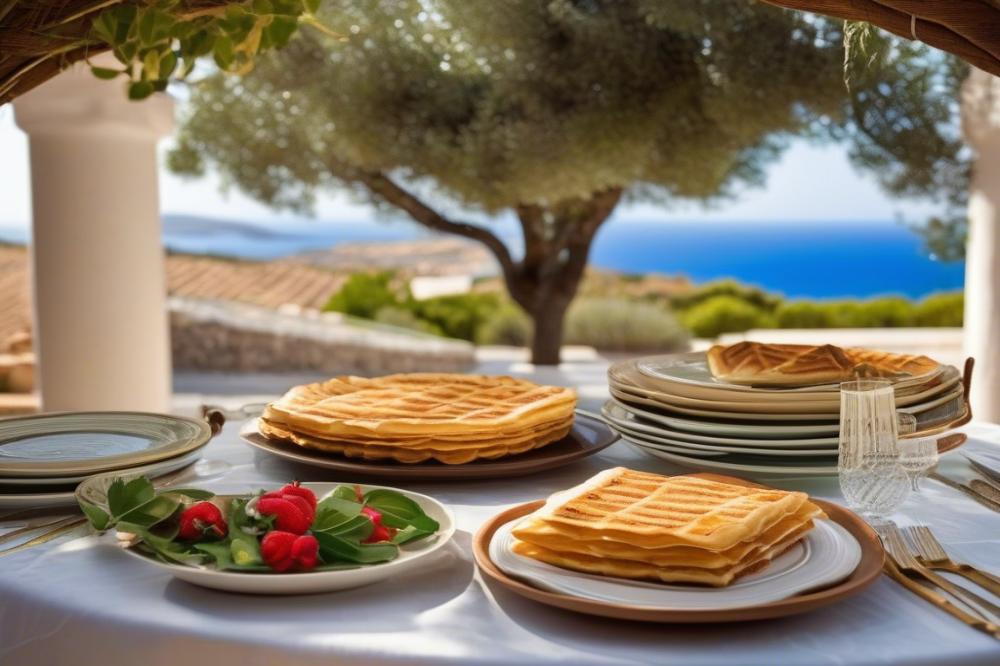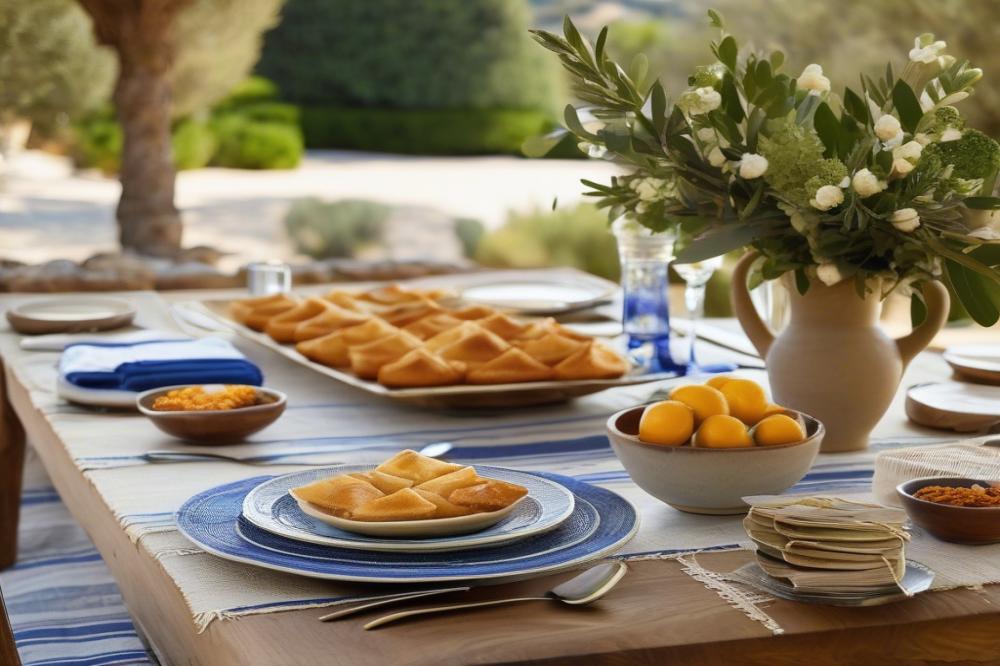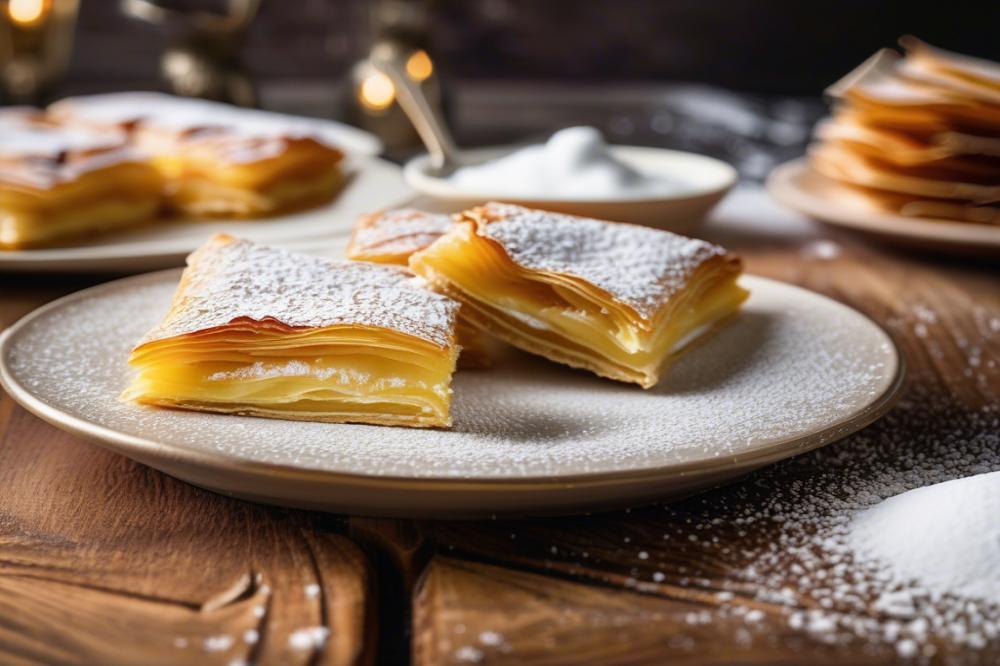Introduction
Bougatsa is a beloved Greek dessert celebrated for its delightful layers of flaky phyllo pastry filled with a rich custard. This sweet treat holds a special place in Greek cuisine, delighting the taste buds of many. Families often gather to enjoy this creamy, pastry-filled delight during various occasions. The history of this dish is woven with tradition, reflecting the cultural tapestry of Greece.
In many households, Bougatsa is more than just food. It represents moments of togetherness and is often prepared in family kitchens on holidays or special events. The delightful smell of baking phyllo wafts through the air, bringing everyone together, creating an atmosphere filled with joy and nostalgia. Children watch their parents expertly use baking techniques to layer the dough, forming a connection to culinary heritage.
This sweet Greek pastry has different variations across regions, yet the cream-filled version remains universally adored. Each bite offers a symphony of textures and flavors, from the crispy layers to the smooth filling. Within Greek desserts, Bougatsa stands out, not just for its taste but also for the memories it creates. The act of making it intertwines with family traditions, ensuring its importance is passed down through generations.
Bougatsa: A Culinary Delight

Definition and History of Bougatsa
Bougatsa is a beloved Greek pastry known for its flaky layers of phyllo pastry and a creamy custard filling. Historically, this treat comes from the Byzantine period and reflects a blend of cultures and influences. It appears that the dessert has roots that run deep in Greece, particularly in Thessaloniki. Bakers traditionally prepared it for special occasions, treating it as a delicacy worth sharing.
Variations in Greek Regions
Different regions in Greece have their own versions of this delightful pastry. In Thessaloniki, the cream-filled variant reigns supreme, often served warm and dusted with powdered sugar. Meanwhile, Crete offers a variation filled with a rich cheese mixture, giving it a savory twist. Visitors to different Greek areas will discover unique spins on this dessert, showcasing local ingredients and flavors. Each recipe tells a story, connected to the heritage of its region, revealing how cooking evolves over time.
The Significance of Bougatsa in Traditional Greek Food
This pastry holds a special place in the hearts of many Greeks. It symbolizes warmth and hospitality while often being a part of morning rituals. Families enjoy it alongside coffee or tea, creating moments of togetherness. In celebrations and gatherings, sweet treats like these become a focal point, providing not just nourishment but also joy. Traditional Greek food comprises a tapestry of flavors, and this pastry is a key thread in that fabric. The baking techniques involved in its creation highlight skill passed down through generations, emphasizing its importance in Greek cuisine.
Ingredients and Preparation

Creating delicious bougatsa involves gathering several key ingredients. Each item plays an important role in making this creamy, sweet pastry come to life. Here’s what you’ll need:
- 1 package of phyllo pastry (about 16 oz)
- 4 cups milk
- 1 cup sugar
- 3 large eggs
- 2 teaspoons vanilla extract
- 1/4 cup cornstarch
- 1/2 cup melted butter
Next, let’s break down the nutritional information for these ingredients:
- Phyllo pastry: Low in calories but high in carbohydrates.
- Milk: Good source of protein and calcium.
- Sugar: Adds sweetness but contributes empty calories.
- Eggs: Provide protein and healthy fats.
- Vanilla extract: Enhances flavor with minimal calories.
- Cornstarch: Thickens the custard while being gluten-free.
- Butter: Rich in fats, adding flavor and texture.
Now, let’s move on to the step-by-step cooking instructions for preparing the custard filling and layering the pastry.
Step-by-Step Instructions
First, prepare the custard filling. In a saucepan, combine the milk, sugar, and cornstarch. Stir this mixture over medium heat until it starts to thicken. It will take a few minutes. Once it thickens, remove it from the heat.
Next, in a bowl, whisk together the eggs and vanilla extract. Slowly add a little of the hot milk mixture into the eggs, stirring constantly. This step prevents the eggs from cooking too quickly. Pour this combined mixture back into the saucepan. Return to low heat and cook for a couple more minutes until it reaches a creamy consistency.
While the custard cools, prepare the phyllo pastry. Preheat your oven to 350°F (about 175°C). Lay out a few sheets of phyllo pastry on a clean surface. Use a brush to coat each layer with melted butter. Don’t skimp on the butter; it helps create a flaky texture.
Layer three sheets of phyllo on top of each other in a baking dish, brushing each with butter. Next, pour half of the custard filling onto the center of this layered pastry. Spread it gently, leaving some space around the edges.
Cover the custard with more layers of phyllo, repeating the buttering process. Continue to layer until you run out of custard and phyllo. Finish with a top layer of phyllo, ensuring it is well-buttered for a golden finish.
Finally, cut slits in the top layer to allow steam to escape. Bake in the preheated oven for about 30 to 40 minutes, or until the pastry is golden brown. Once baked, allow it to cool slightly before serving. This dish embodies the essence of Greek desserts, balancing rich layers and a smooth custard filling.
Mastering Baking Techniques

Making the perfect Greek dessert requires precision and care. Handling phyllo pastry is an art. First, always keep the sheets covered. Phyllo dries out quickly if exposed to air. Use a damp towel to cover them as you work. This keeps the layers pliable and manageable.
When assembling your sweet treats, work on a clean surface. Lay one sheet of the pastry down gently. Brush it with melted butter to add flavor and richness. Then, layer another sheet on top. This process should be repeated, creating numerous layers. Aim for at least six to eight sheets for a robust structure. This will create a crisp, flaky texture once baked.
How to Achieve Perfect Layers in Bougatsa
Creating the ideal layers requires patience. Carefully spread the custard filling along one edge of the layered pastry. Avoid overfilling, as this can make rolling difficult. Once filled, gently roll it up, tucking in the sides as you go. This results in a neat package. Always position the seam side down on the baking tray for stability.
Baking techniques play a critical role in achieving that golden color. Setting your oven to the right temperature is essential. Generally, a temperature of 375°F (190°C) works best. Bake for about 30 to 40 minutes. Keep an eye on it, as ovens can vary. Look for a crispy golden brown finish on the pastry. A perfect layer should be both flaky and airy.
Baking Times and Temperatures for Optimal Results
Timing is everything in baking. After about 20 minutes, check for signs of browning. The aroma of baked phyllo should fill your kitchen. Broil for just a moment at the end if a little extra color is desired. Be cautious not to burn the pastry edges. Allow it to cool slightly before serving. Enjoy this traditional Greek food warm or at room temperature. Each bite should be a delightful mix of crispy pastry and creamy filling.
Serving and Variations

How to Serve Bougatsa: Garnishing and Toppings
Serving this delightful pastry is an art in itself. Dusting the surface with powdered sugar adds a touch of sweetness. Some also sprinkle cinnamon on top for an extra layer of flavor. Whipped cream can be served on the side as a delightful addition. A drizzle of honey enhances the experience, creating a beautiful contrast to the creamy filling. A slice of lemon may provide a zesty kick, brightening the taste. Presentation matters, too. Arrange the pieces on a decorative plate for a welcoming touch.
Exploring Different Fillings
This dessert can embrace various flavor profiles. While the classic version features a custard filling, savory options exist as well. Spinach and feta create a delightful combination for those craving something hearty. Meat and cheese variations are popular among many families, showcasing the versatility of the pastry. Beyond savory fillings, other sweet variations are noteworthy. Chocolate or almond paste provide a unique twist for adventurous eaters. Fruit fillings, like cherry or apple, can also be delightful, catering to diverse preferences. Each variation brings something special to the table, reflecting the richness of Greek cuisine.
Cultural Significance of Serving Bougatsa in Greek Households
In many Greek families, serving this creamy pastry holds deep meaning. It is often found during festive occasions and celebrations. Traditionally, it brings people together, symbolizing hospitality and comfort. The smell of baking wafts through homes, creating an inviting atmosphere. Gatherings become more special when this treat is shared among friends and family. Children and adults alike eagerly await their turn to taste a piece. Conversations flow, and laughter shares the space, enhancing the overall experience. This pastry is more than just a dessert; it embodies cherished moments in life.
The Sweet Legacy of Bougatsa
Bougatsa holds a special place in Greek cuisine, beloved by many for its delightful layers of pastry and rich, cream-filled interior. This dessert is not just food; it represents tradition, warmth, and a sense of home. For generations, families have gathered to enjoy this treat, making memories around the table. Such dishes are an essential part of cultural heritage, connecting people through shared experiences and flavors.
Trying to make this pastry at home can be a rewarding experience. It may seem daunting at first, but the process can be enjoyable. From preparing the delicate dough to filling it with delicious cream, each step brings joy and anticipation. When you take that first bite of your homemade creation, the satisfaction will be sweet.
For those who enjoy culinary adventures, exploring more traditional Greek recipes is an excellent idea. Each recipe offers a glimpse into the customs and tastes of Greece. Discovering these dishes can be fun and educational. The vibrant flavors, unique combinations, and cultural significance make cooking these meals worthwhile.
In summary, the charm of preparing this delightful dessert lies in its rich history and the joy it brings. So why not roll up your sleeves and dive into the art of creating your own delectable treat? You may find that the experience is just as fulfilling as the delicious outcome.



